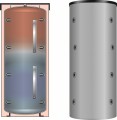It is the material of the heat-insulating layer applied in the tank.
—
Polyurethane foam. It has excellent performance specs and surpasses all other materials of a similar purpose in terms of the quality of thermal insulation. Polyurethane foam is quite expensive, but it is almost invisible compared to the total cost of storage tanks. Thanks to all this, this option is perhaps the most popular in modern storage tanks.
—
Polyester fibre. Thermal insulation based on synthetic fibre made of polyester. The actual capabilities of such insulation directly depend on the density of the fibre, and the cost of the filler also depends on the density. Therefore, when assessing the overall quality of such thermal insulation, it is worth looking first of all at the price category of the tank. In general, the insulating specs of polyester fibre are average, somewhat inferior to expanded polystyrene.
— Styrofoam. One of the remarkable features of this material is its very low weight (because more than 90% of the volume of polystyrene foam is air). In terms of thermal insulation coefficient, it is one and a half to two times inferior to polyurethane foam; however, it is also cheaper.
— Mineral wool. Thermal insulation based on fibres formed from minerals and a binder (eg. phenol). It has a low cost and fairly decent heat-insulating specs. At the same time, mineral wool tends to
...accumulate moisture, and this leads to a loss of insulating abilities; in addition, there is evidence that such a filler can release harmful substances. Therefore, when using a heat accumulator with such insulation, special care must be taken to ensure that its outer shell remains intact.The diameter of the connecting pipes provided in the storage tank. Traditionally specified in inches and fractions of an inch — for example, 1/2" or 1 1/4"; at the same time, the larger the tank, the larger the connection.
In some cases, it is allowed to connect pipes of a different diameter to the heat accumulator through appropriate adapters.

